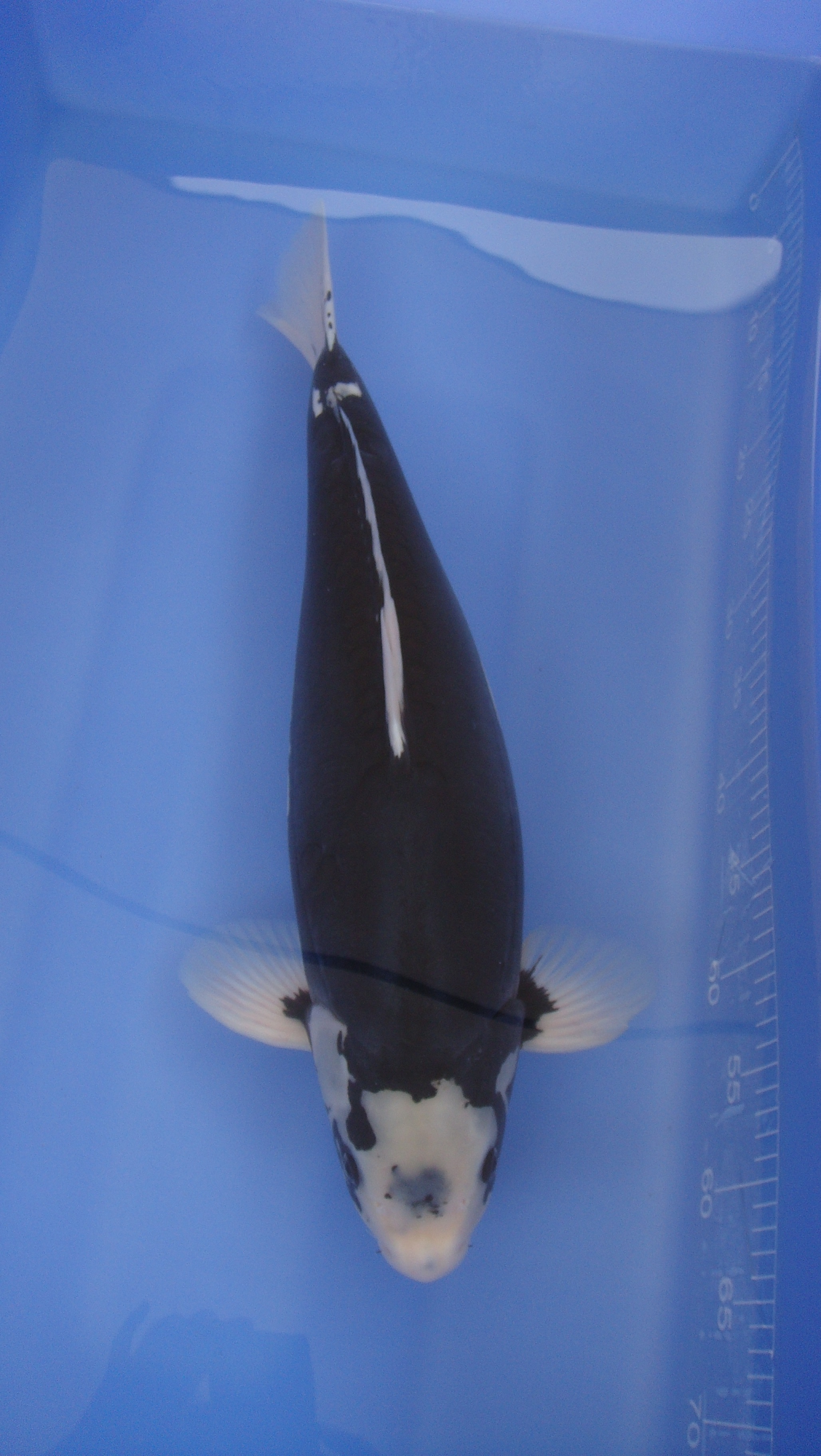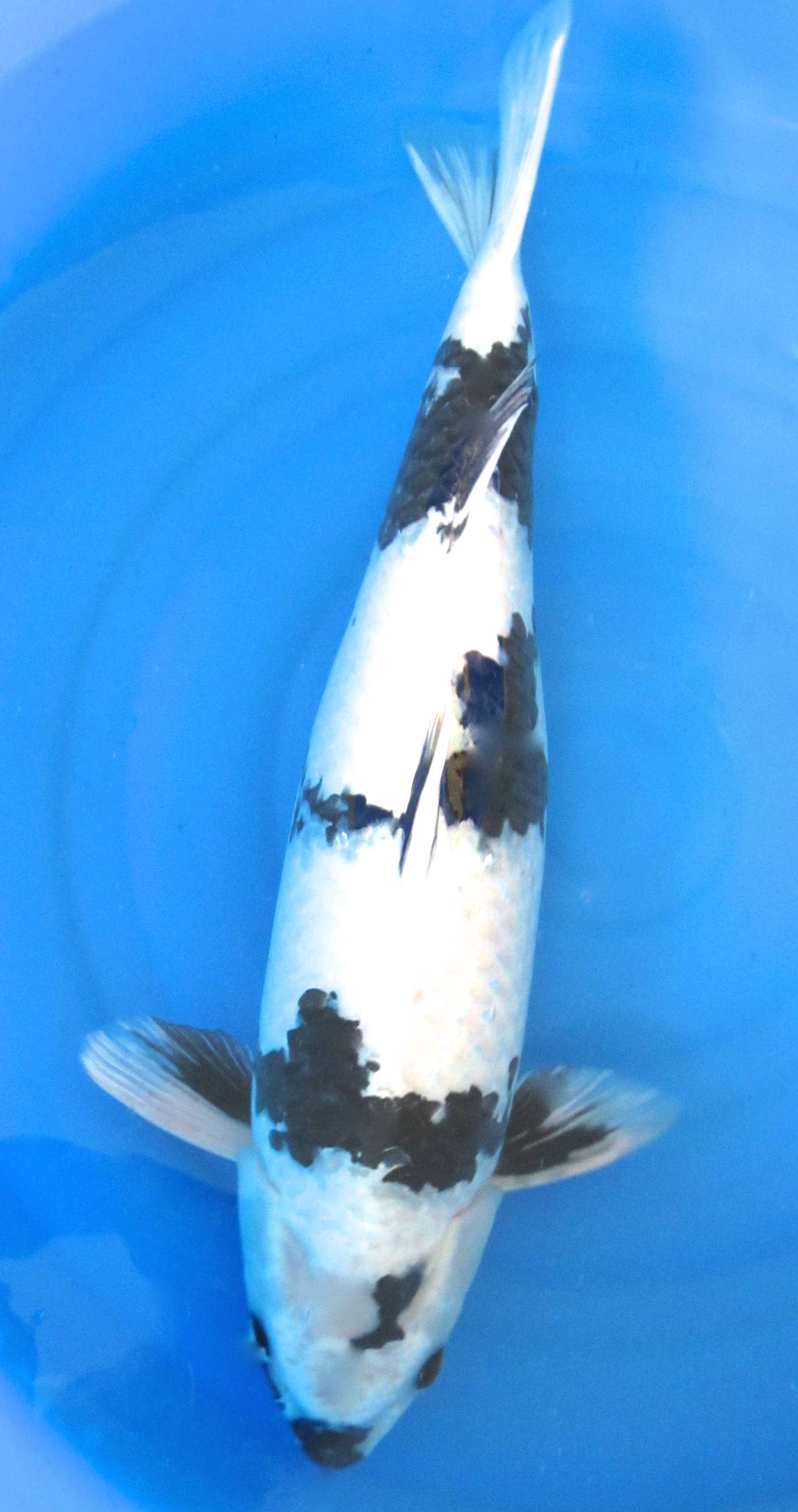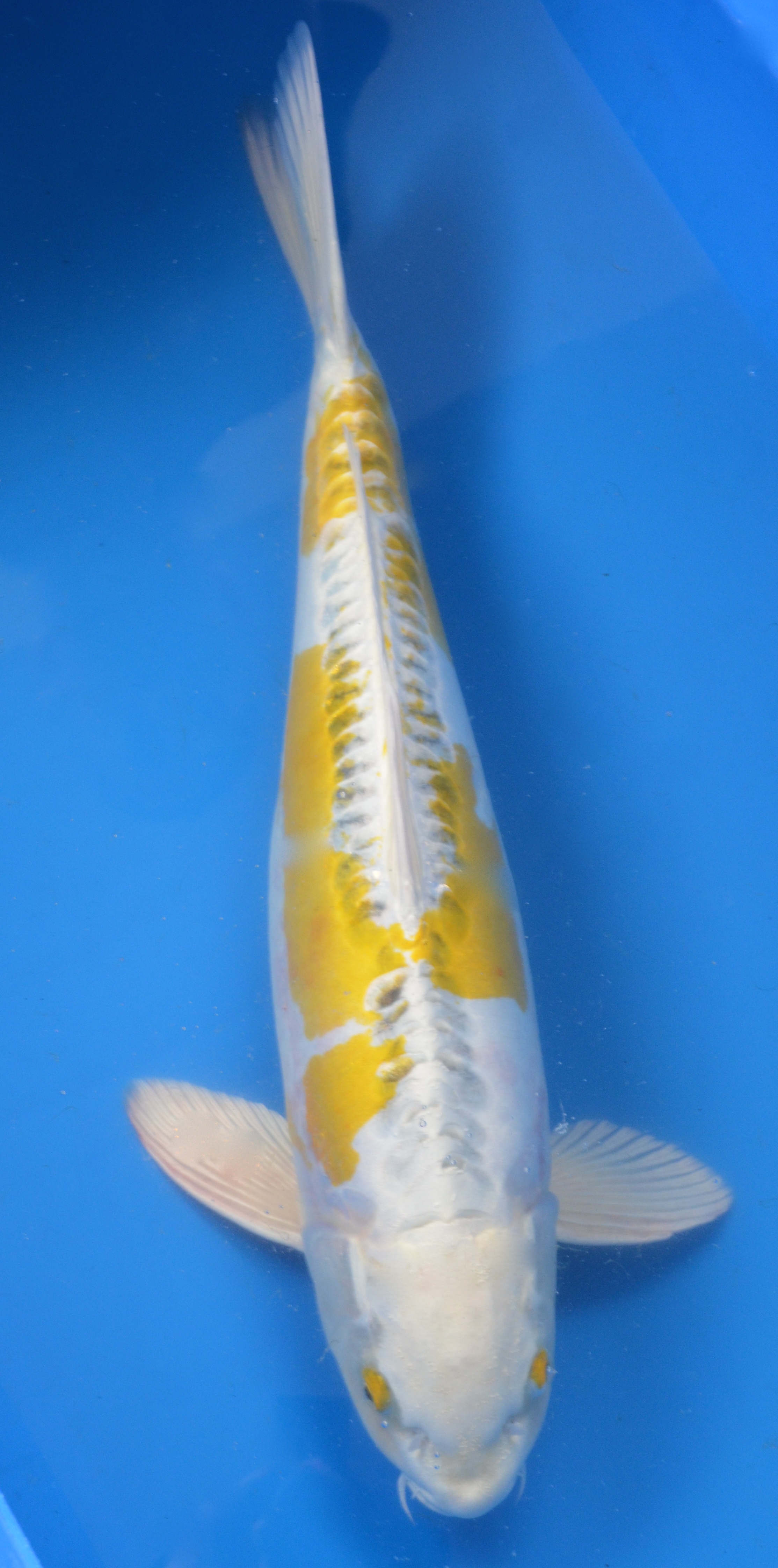Koi Varieties
History
Records of common carp date back about 2500 years. Colour mutations from the basic black carp (known as Magoi) started to be developed only about 200 years ago, with most of the beautiful varieties that we know today as nishikigoi being established around the beginning of this century.
Description of Varieties
Kohaku | Sanke | Showa | Bekko | Utsurimono | Asagi | Shusui
Koromo | Kawarimono | Hikarimono | Hikari - Utsurimono | Hikarimoyo- Mono | Tancho | Kinginrin
Here is a very brief guide to the different varieties. The photos are of our members prize winning fish.
Kohaku
 Kohaku, white koi with red (hi, pronounced 'he' ) markings. Probably the most common variety. The hi should be deep red with well defined edges (kiwa) where it meets the white which should be pure and bright. A tancho kohaku is a white koi with a red spot on its head. An inazuma kohaku has a continuous red marking from the head to the tail, but with variation (inazuma means 'lightning strike'). A nidan (two) kohaku has two red markings, a sandan (three) kohaku has three red markings, and a yondan (four) kohaku has four red markings. Kohaku, white koi with red (hi, pronounced 'he' ) markings. Probably the most common variety. The hi should be deep red with well defined edges (kiwa) where it meets the white which should be pure and bright. A tancho kohaku is a white koi with a red spot on its head. An inazuma kohaku has a continuous red marking from the head to the tail, but with variation (inazuma means 'lightning strike'). A nidan (two) kohaku has two red markings, a sandan (three) kohaku has three red markings, and a yondan (four) kohaku has four red markings.
Taisho sanke
 Taisho sanke (known as sanke), hi (red) and sumi (black) on a white background. A maruten sanke has a separate red spot on the head with normal markings on the body. A tancho sanke has a red spot on the head and a white body with black markings. Taisho sanke (known as sanke), hi (red) and sumi (black) on a white background. A maruten sanke has a separate red spot on the head with normal markings on the body. A tancho sanke has a red spot on the head and a white body with black markings.
Showa sanshoku
 Showa sanshoku (known as showa), red and white markings on a black background. A hi showa is a predominantly red showa. A kindai showa has a predominantly white pattern. A tancho showa has a red spot on the head and a black body with white markings. Showa sanshoku (known as showa), red and white markings on a black background. A hi showa is a predominantly red showa. A kindai showa has a predominantly white pattern. A tancho showa has a red spot on the head and a black body with white markings.
Bekko
 Bekko are white, red or yellow koi with black (sumi) markings. Shiro bekko is a white koi with black markings. Aka bekko is a red koi with black markings (aka is another word for red). Ki bekko is a yellow koi with black markings (rare variety). Bekko are white, red or yellow koi with black (sumi) markings. Shiro bekko is a white koi with black markings. Aka bekko is a red koi with black markings (aka is another word for red). Ki bekko is a yellow koi with black markings (rare variety).
Utsurimono
 Utsuri are often confused with bekko but are mostly black with white, red or yellow markings. Shiro utsuri is a black koi with white markings. Hi utsuri is black with red markings. Ki utsuri is black with yellow markings (rare variety). Utsuri are often confused with bekko but are mostly black with white, red or yellow markings. Shiro utsuri is a black koi with white markings. Hi utsuri is black with red markings. Ki utsuri is black with yellow markings (rare variety).
Asagi
 Asagi are blue-grey koi with red along the sides and belly and in the fins. Asagi are blue-grey koi with red along the sides and belly and in the fins.
Shusui
 Shusui are doitsu koi (koi with scales along dorsal and lateral lines only). They are blue-grey with dark blue scales along the dorsal and lateral lines and red on the sides and fins. Shusui are doitsu koi (koi with scales along dorsal and lateral lines only). They are blue-grey with dark blue scales along the dorsal and lateral lines and red on the sides and fins.
Koromo
 Koromo literally means 'robed'. This describes the hi pattern, outlined in a darker colour, which varies with the variety. Ai goromo is a kohaku whose scales have blue borders. Sumi goromo have solid black on the hi markings. Budo goromo have sumi overlaying the hi giving a purple/maroon colour. Koromo literally means 'robed'. This describes the hi pattern, outlined in a darker colour, which varies with the variety. Ai goromo is a kohaku whose scales have blue borders. Sumi goromo have solid black on the hi markings. Budo goromo have sumi overlaying the hi giving a purple/maroon colour.
Kawarimono
 Kawarimono accomodates all non-metallic koi that do not fall into the above groups : Kawarimono accomodates all non-metallic koi that do not fall into the above groups :
Karasugoi is a black koi with white or orange belly.
Hajiro is a black koi with white tips to its tail and pectoral fins.
Hageshiro is a black koi with white tips to its fins and white head and nose.
Kumonryu is a doitsu koi which is black with white markings on its head, fins and body.
Aka matsuba is a red koi with black centres to its scales, creating a pine cone effect.
Ki matsuba as above but yellow.
Shiro matsuba as above but white.
Goshiki are white, red, black, blue and dark blue, giving a purplish appearance.
Kigoi is a yellow koi.
Chagoi is a light brown/olive koi.
Soragoi is a blue-grey koi.
Midorigoi is a green koi.
Benigoi is a deep red koi.
Shiro muji is a white koi, aka muji is a red koi.
Ochiba shigure is blue-grey with a brown pattern.
Hikarimono
 Hikarimono is a group of single coloured metallic koi : Hikarimono is a group of single coloured metallic koi :
Platinum ogon is a metallic white koi.
Nezu ogon is a metallic silver grey koi.
Yamabuki ogon is a yellow-gold metallic koi.
Orenji ogon is a deep metallic orange koi.
Kin matsuba is a metallic gold or orange koi whose scales have black centres, causing a pine cone effect.
Gin matsuba is the silver version.
Hikari Utsurimono
 Hikari - Utsurimono are basically metallic showa and utsuri. Hikari - Utsurimono are basically metallic showa and utsuri.
Kin showa have a golden lustre while gin showa have a silver lustre.
Gin shiro is a metallic shiro utsuri.
Kin ki utsuri is a metallic yellow utsuri.
Kin hi utsuri is a metallic red utsuri.
Hikarimoyo Mono
 Hikarimoyo - Mono are other metallic koi that have more than one colour but aren't showa or utsuri. Hikarimoyo - Mono are other metallic koi that have more than one colour but aren't showa or utsuri.
Yamato-nishiki is basically a metallic sanke.
Kujaku are platinum koi with hi markings. The scales are overlaid with a matsuba pattern.
Platinum kohaku is a metallic kohaku.
Kikisui is a doitsu platinum kohaku.
Gin bekko is a metallic shiro bekko.
Kinsui and ginsui are the metallic varieties of shusui.
Hariwake are platinum with orange (orenji hariwake) or yellow (yamabuki hariwake) markings. They can be normally scaled, doitsu, matsuba (pine cone effect) or doitsu matsuba.
Tancho
 Tancho are named after the national bird of Japan, the tancho crane, which has a red spot on the head. There are tancho kohaku, tancho sanke and tancho showa (see kohaku, sanke and showa descriptions). Tancho are named after the national bird of Japan, the tancho crane, which has a red spot on the head. There are tancho kohaku, tancho sanke and tancho showa (see kohaku, sanke and showa descriptions).
Kinginrin
 Kinginrin literally means 'golden silvery scales' and describes the sparkling scales of kinginrin koi. Koi of all varieties can have kinginrin scales, they must have more than about 20 to be classed as kinginrin. Kinginrin literally means 'golden silvery scales' and describes the sparkling scales of kinginrin koi. Koi of all varieties can have kinginrin scales, they must have more than about 20 to be classed as kinginrin.
Koi with silver sparkling scales are ginrin and those with golden sparkling scales are kinrin. Koi with both are kinginrin.
^ back to top
|